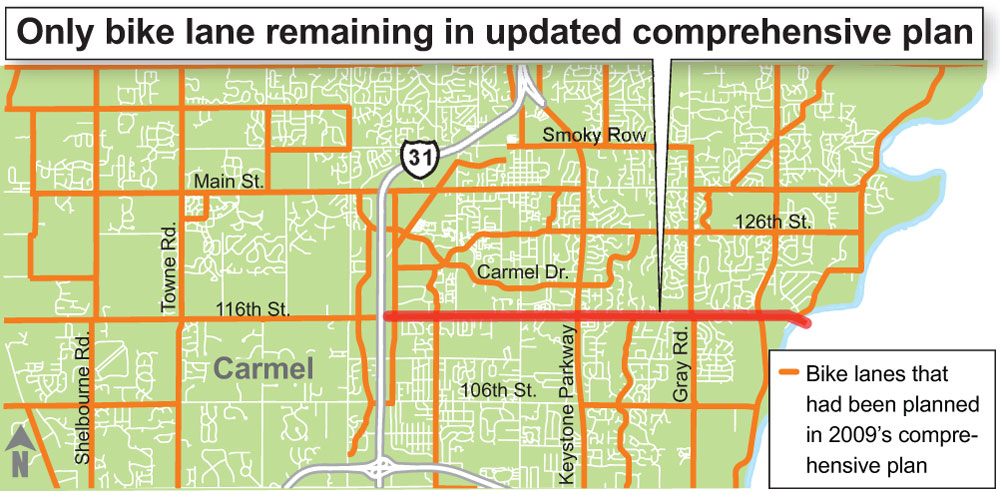
By Adam Aasen
The Carmel City Council is working on changes to the area’s comprehensive plan that could expand the city’s right-of-ways and modify bike lanes around town.
Some residents have voiced concerns that the changes to road widths could mean their yards would be getting smaller. But councilors are working to strike a compromise between making the city bicycle-friendly and protecting neighbors’ property rights.
The C3 Comprehensive Plan was adopted in 2009 as a guideline for the city when new commercial or residential projects take place. City officials can choose to deviate from the plan if necessary, but this detailed document tries to keep planners on the same page.
Planners originally developed an ambitious vision for Carmel with multiple bike and pedestrian lanes through most major thoroughfares. It was important to make the city “walkable,” something Mayor Jim Brainard has said he sees as a point of pride in Carmel.
The C3 Plan doesn’t mandate that construction begin all at once, but slowly as the city identifies new road projects, and the vision has begun to take shape in small steps. City Councilor Carol Schleif said this has led to angry phone calls from homeowners who are the first to be affected by mandatory bike paths and widened sidewalks.
As a result, the City Council is making amendments to the C3 Plan. They are looking to eliminate some bike lanes, change some requirements to mere suggestions and tinker with appropriate widths. Compromises could include going with a bike lane on one side instead of both sides of the street. Another major tool to keep the peace is utilizing “multi-use paths” which are essentially widened sidewalks that can support cyclists. That way, residents don’t feel their homes are too close to the road, but cycling is still supported.
“If the path is going to be less than five feet off their front door, that’s common sense that we wouldn’t do that,” said Councilor Kevin “Woody” Rider at a City Council land use committee meeting on April 22.
To expand all of these right-of-ways, the city needs to purchase land in some cases. There’s also the construction cost. But city planning officials say approving the changes doesn’t put Carmel on the hook to suddenly pony up lots of money to transform every single street. In some cases, new property developers will agree to pay for changes as a part of zoning approval. In other situations, these changes would be implemented within the regular course of road maintenance, which can take some time.
While bike lanes seem to grab people’s attention, the proposed changes also call for an increased presence of boulevards, which means widened streets with landscaped medians in the center. The plan calls for such construction on far western and eastern areas of Main Street, among other areas.
Brainard said that boulevards move a tremendous of traffic in a way that doesn’t required a neighborhood to be cut up with a wide patch of asphalt.
“By using roundabouts it is not necessary to make all of our roads four lanes, and the center trees in medians allows a green tree canopy to be established in a relatively short period of time,” he said. “This makes our city a more functional and beautiful place to live and work.”
With changes being made to the comprehensive plan, some city councilors felt it was time for a larger discussion.
Schleif asked if it was possible to consider a major overhaul of the plan. She pointed to the glaring absence of Southwest Clay Township in the planning maps, an area that she represents that wasn’t annexed yet when the comprehensive plan was originally adopted.
“We’ve been part of Carmel, for, you know, how long?” she said. “That map should be fixed.”
Planning officials agreed with Schleif but urged that the council focus on the traffic changes first and other issues could be addressed later. While minor changes can be made, a major overhaul of the plan just isn’t in the consulting budget for Carmel at this time.
The resolution remains in committee and Councilor Rick Sharp said he hopes to bring it for a vote in July.
[gview file=”https://youarecurrent.com/wp-content/uploads/2014/04/Comparison-Map-11×17.pdf”]
[gview file=”https://youarecurrent.com/wp-content/uploads/2014/04/Bikes-paths-page-20.pdf”]



